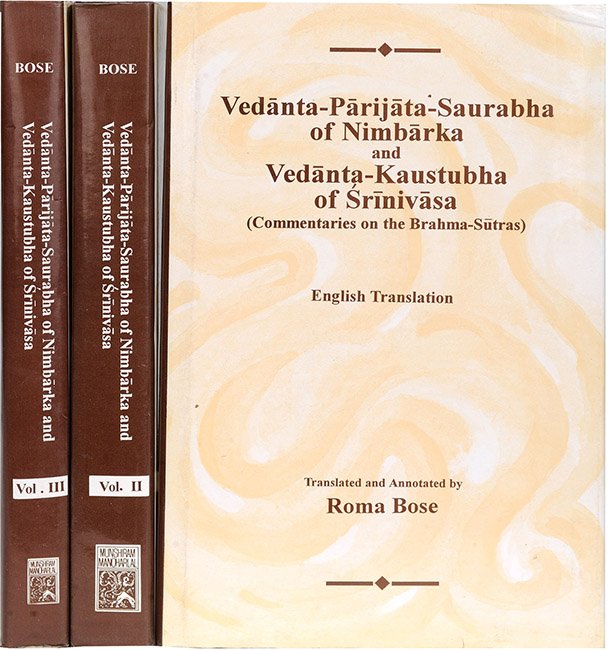Brahma Sutras (Nimbarka commentary)
by Roma Bose | 1940 | 290,526 words
English translation of the Brahma-sutra 1.4.8, including the commentary of Nimbarka and sub-commentary of Srinivasa known as Vedanta-parijata-saurabha and Vedanta-kaustubha resepctively. Also included are the comparative views of important philosophies, viz., from Shankara, Ramanuja, Shrikantha, Bhaskara and Baladeva.
Brahma-Sūtra 1.4.8
English of translation of Brahmasutra 1.4.8 by Roma Bose:
“(the word ‘unborn’ does not denote the sāṃkhya prakṛti) on account of non-specification, as in the case of the cup.”
Nimbārka’s commentary (Vedānta-pārijāta-saurabha):
On the prima facie view, viz. Let prakṛti, mentioned in the sacred text: ‘One unborn female (ajā)’ (Śvetāśvatara-upaniṣad 4.5[1]), be the one established in (the Sāṃkhya) Smṛti, the author indicates the right conclusion. The unborn one, mentioned in the sacred text, must have Brahman for its soul[2], because there is no specification guaranteeing the prima facie view[3], as in the case of the cup, mentioned in the sacred text: ‘There is a cup with its mouth below’ (Bṛhadāraṇyaka-upaniṣad 2.2.3[4]).
Śrīnivāsa’s commentary (Vedānta-kaustubha)
Thus, it has been shown that in the Kaṭha-vallī pradhāna, which is not mentioned in the Veda, is not denoted by the term ‘unmanifest’, as it, through denoting the cause, viz. pradhāna which is mentioned in the Veda, denotes its effect, viz. the body. It has also been shown that as pradhāna has Brahman for its soul, the text, thereby, refers to Brahman. In a like manner, it is being shown now that the text about the unborn one, too, refers to Brahman alone.
In the Mantropaniṣad of the Śvetāśvataras, we find the following: ‘By an unborn female (ajā),[5] red, black and white, bringing forth manifold offspring of a like nature, there lies an unborn male (aja)[6], enjoying. Another unborn male (aja) leaves her who has been enjoyed’ (Śvetāśvatara-upaniṣad 4.5). A doubt arises, viz. whether in this sacred text prakṛti, established by the Sāṃkhya-smṛti, is recognized by the term ‘unborn one’ (ajā), or whether the meaning of the sacred text is prakṛti, having Brahman for its soul. On the prima facie view, viz. The ‘unborn one’, etymologically derived as ‘one who is not born’; self-supporting; independently bringing forth, by nature, offspring of a like nature; consisting in the three guṇas; the cause of the distinction between bondage and release; and admitted by the Sāṃkhyas, should be understood to be mentioned by the sacred text as well.
We reply: The ‘unborn one’, which has Brahman for its soul, is mentioned by the sacred text. Why? “On account of nonspecification”, i.e. because there is no special circumstance for understanding pradhāna which is derived from inference. Our (i.e. Upaniṣadic) (prakṛti), too, is unborn. Since a scriptural text is authoritative only in reference to its own explicit meaning, i.e. only in reference to what it actually states, a self-supporting one is not recognized here, because the word ‘self-supporting’ is found nowhere, and also because it is impossible for a non-sentient object to have an independent existence. An example illustrating the absence of any specification, such as: ‘This is so’, with regard to a common term, is given in the words: “As in the case of a cup”. In the text: ‘There is a cup with its mouth below, and bottom above’ (Bṛhadāraṇyaka-upaniṣad 2.2.3), the word ‘cup’ (camasa) conveys only the idea of an implement used in eating, in accordance with the etymology: (A ‘camasa’ is that) whereby one drinks (camyate anena); and so no accurate specific determination, that a cup (camasa) is such, is possible, on account of non-specification,—(the marks of) having the mouth below and the rest being possible elsewhere too.[7] Similarly, in the sacred text under discussion also, there can be no specifying out that this prakṛti, simply because it is unborn, is the one established by the Sāṃkhya-smṛti.
Footnotes and references:
[1]:
Quoted by Śaṅkara, Rāmānuja, Bhāskara, Śrīkaṇṭha and Baladeva.
[2]:
I.e. be dependent on Brahman.
[3]:
I.e. There is nothing here to guarantee us in selecting pradhāna of the opponents as the unborn one.
[4]:
Quoted by Śaṅkara, Rāmānuja, Bhāskara, Śrīkaṇṭha and Baladeva.
[5]:
‘Ajā’ means a she-goat, too, of. Brahma-sūtras (Śaṅkara’s commentary) 1.4.10, p. 404.
[6]:
‘Aja’ means a he-goat also.
[7]:
I.e. in the above text about the ‘ajā’, there are no special marks which justify us in selecting out the Sāṃkhya prakṛti here out of other possible meanings of the term ‘ajā’, just as in the text about the ‘camasa’, there are no special marks for fixing what exactly a camasa denotes here, until we are told specifically in the complementary passage that it denotes the head.
